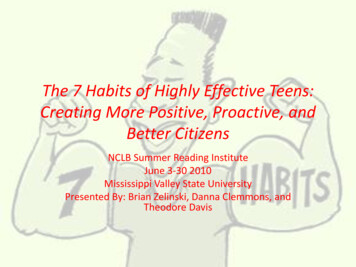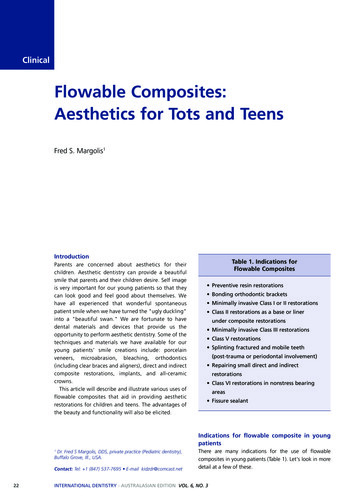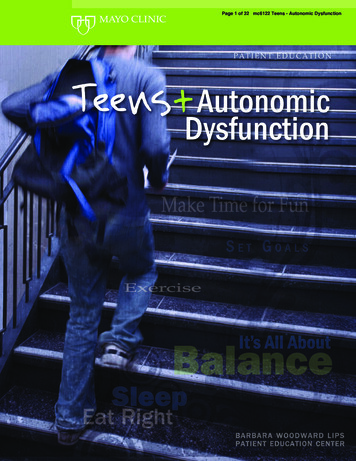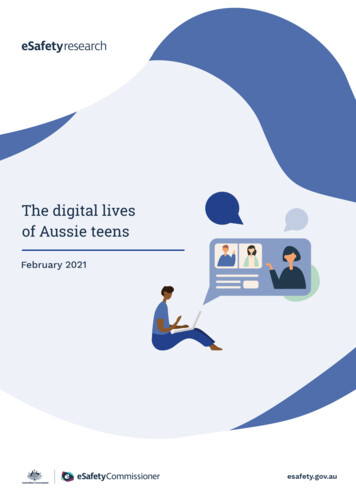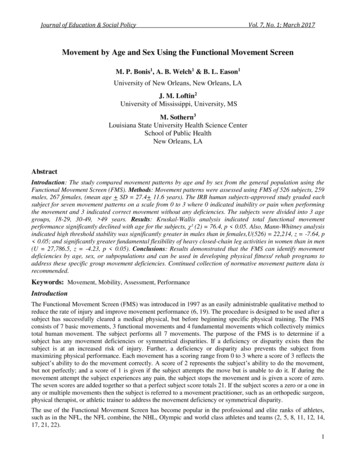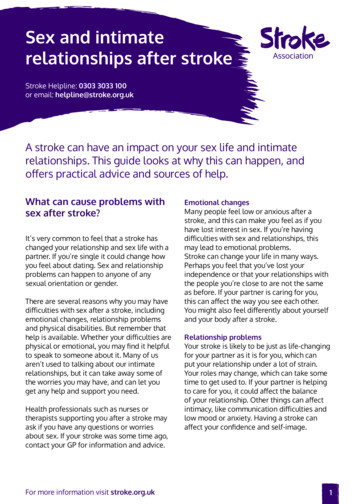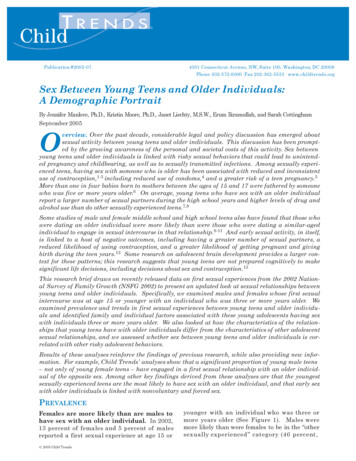
Transcription
Publication #2005-074301 Connecticut Avenue, NW, Suite 100, Washington, DC 20008Phone 202-572-6000 Fax 202-362-5533 www.childtrends.orgSex Between Young Teens and Older Individuals:A Demographic PortraitBy Jennifer Manlove, Ph.D., Kristin Moore, Ph.D., Janet Liechty, M.S.W., Erum Ikramullah, and Sarah CottinghamSeptember 2005Overview. Over the past decade, considerable legal and policy discussion has emerged aboutsexual activity between young teens and older individuals. This discussion has been prompted by the growing awareness of the personal and societal costs of this activity. Sex betweenyoung teens and older individuals is linked with risky sexual behaviors that could lead to unintended pregnancy and childbearing, as well as to sexually transmitted infections. Among sexually experienced teens, having sex with someone who is older has been associated with reduced and inconsistentuse of contraception,1-3 including reduced use of condoms,4 and a greater risk of a teen pregnancy.5More than one in four babies born to mothers between the ages of 15 and 17 were fathered by someonewho was five or more years older.6 On average, young teens who have sex with an older individualreport a larger number of sexual partners during the high school years and higher levels of drug andalcohol use than do other sexually experienced teens.7,8Some studies of male and female middle school and high school teens also have found that those whowere dating an older individual were more likely than were those who were dating a similar-agedindividual to engage in sexual intercourse in that relationship.9-11 And early sexual activity, in itself,is linked to a host of negative outcomes, including having a greater number of sexual partners, areduced likelihood of using contraception, and a greater likelihood of getting pregnant and givingbirth during the teen years.12 Some research on adolescent brain development provides a larger context for these patterns; this research suggests that young teens are not prepared cognitively to makesignificant life decisions, including decisions about sex and contraception.13This research brief draws on recently released data on first sexual experiences from the 2002 National Survey of Family Growth (NSFG 2002) to present an updated look at sexual relationships betweenyoung teens and older individuals. Specifically, we examined males and females whose first sexualintercourse was at age 15 or younger with an individual who was three or more years older. Weexamined prevalence and trends in first sexual experiences between young teens and older individuals and identified family and individual factors associated with these young adolescents having sexwith individuals three or more years older. We also looked at how the characteristics of the relationships that young teens have with older individuals differ from the characteristics of other adolescentsexual relationships, and we assessed whether sex between young teens and older individuals is correlated with other risky adolescent behaviors.Results of these analyses reinforce the findings of previous research, while also providing new information. For example, Child Trends’ analyses show that a significant proportion of young male teens– not only of young female teens – have engaged in a first sexual relationship with an older individual of the opposite sex. Among other key findings derived from these analyses are that the youngestsexually experienced teens are the most likely to have sex with an older individual, and that early sexwith older individuals is linked with nonvoluntary and forced sex.PREVALENCEFemales are more likely than are males tohave sex with an older individual. In 2002,13 percent of females and 5 percent of malesreported a first sexual experience at age 15 or 2005 Child Trendsyounger with an individual who was three ormore years older (See Figure 1). Males weremore likely than were females to be in the “othersexually experienced” category (46 percent,
STATE LAWS ADDRESSING ILLEGAL SEXWITHMINORSLaws addressing illegal sexual relations with minors are designed to protect young people from sexualexploitation.14 Each state has its own legal definition of when having sexual relations with a minor is considered illegal. Most often, specific reporting requirements related to criminal sexual acts with minors are foundin sections of a state’s civil code that describe child abuse reporting. Only five states specifically use the term“statutory rape,” even though each state documents criminal sexual acts based on the age of legal consent,often in combination with age differences between minors and older individuals. According to a recent publication by The Lewin Group,14 each state sets an age when individuals legally can consent to sexual intercourse, regardless of the age of the individual with whom they are having sex. Thirty-four states set this ageof consent as 16. However, only 12 states include a single age of consent. The remaining 38 states and theDistrict of Columbia also include language about age differences, the minimum age of the minor, and/or theminimum age of the defendant (in cases of prosecution). Those states that include age differential requirements most often set these at a two-to-five-year age difference. State laws are based on the age of the partiesinvolved, even if both parties believe the contact was voluntary, motivated by the understanding that minorsbelow a certain age cannot legally consent to sexual intercourse.All states have laws mandating the reporting of child abuse, but these laws vary considerably in theirdefinitions, scope, and procedures. State child abuse laws typically mandate that professionals who are in contact with children must report child abuse and neglect. These laws apply generally to teachers, health careproviders, child care workers, clergy members, legal professionals, and state employees who work with children.14 Federal agencies that provide funding for programs for children and adolescents are subject to childabuse reporting requirements in compliance with state laws. For example, Title X - the U.S. government’sprogram that provides funding for family planning services - includes appropriations language which statesthat family planning providers are not exempt from state reporting requirements. Each year since 1999,appropriations language for the Title X program has clarified the responsibility of health care providers toreport by stating that: “Notwithstanding any other provision of law, no provider of services under Title X ofthe Public Health Service Act shall be exempt from any State law requiring notification, or the reporting ofchild abuse, child molestation, sexual abuse, rape, or incest.”15,16ABOUT THE RESEARCH SOURCE FOR THIS BRIEFThe 2002 National Survey of Family Growth (NSFG 2002), conducted by the National Center forHealth Statistics (NCHS), is designed to provide reproductive health information about men and womenbetween the ages 15 to 44. To learn more about sexual relationships between young teens and older individuals, we limited our sample to 2,059 males and 2,513 females between the ages of 15 and 24 in 2002, withretrospective information on their age at first sexual intercourse and the age of the individual with whom theyfirst had sex. Comparison information is available for 2,934 females in 1995.Child Trends analyzed these data to examine first sexual experiences that occurred during the middleand secondary school years (under the age of 18). In these analyses, we defined young teens as those who were15 and younger at first sex, because 16 is the most common state-mandated age of consent. We defined anolder individual as someone who was three or more years older than such a young teen at first sex, because anumber of states include this age difference in their language about sex with minors.14 This brief presentsinformation on those respondents in the sample whose first sexual experience occurred when they were aged15 or younger with an individual who was three or more years older (“sex between young teens and olderindividuals”), compared with respondents in two other groups: those whose first sexual experience was beforethe age of 18 but was not classified as sex between young teens and older individuals (referred to as “othersexually experienced”), and those who did not experience sexual intercourse before the age of 18 (referred toas “not sexually experienced”). All differences presented are statistically significant (p .05). Note thatbecause sexual relationships between young teens and older individuals are often exploitive and coercive, we usethe term “older individual”instead of "older sexual partner" within this brief.compared with 36 percent of females). Aboutone-half of females (52 percent) and males (49percent) did not experience sexual intercoursebefore age 18. Additional analyses (not shown ina figure) indicate: Overall, males represented 26 percent ofteens whose first sexual relationship2occurred at age 15 or younger with someonethree or more years older. Amongthosewhoweresexuallyexperienced, females (26 percent) were morelikely than were males (9 percent) to reportthat their first experience with sexual intercourse was at age 15 or younger with anindividual who was at least three years older. 2005 Child Trends
70%Percentage of Young TeensWhose First Sex Was with anIndividual 3 Years Older,by Age at First Sex60%50%40%Prevalence of SexBetween Young Teens andOlder IndividualsNot SexuallyExperienced20%10%Male 15,Female 3 Years Older0%Source: National Survey of Family Growth 2002Figure 230%Figure 1Female 15,Male 3 YearsOlderThe prevalence of sex between youngfemale teens and older males did notchange between 1995 and 2002. Separateanalyses of data from 1995 (not shown here)indicate that the percentage of young femaleteens having sex at age 15 or younger with anolder male remained essentially stable between1995 (14 percent) and 2002 (13 percent). Comparable data are not available for male teens.OtherSexuallyExperienced 18NotSexuallyExperiencedOtherSexuallyExperienced 18Source: National Survey of Family Growth 2002INDIVIDUAL AND FAMILY FACTORSThe youngest sexually experienced teensare the most likely to have sex with anolder individual.The younger teens wereat the time of their first experience with sexualintercourse, the more likely they were to havehad that experience with an individual who wasat least three years older (See Figure 2). Almost two-thirds (65 percent) of femaleswho were aged 13 or younger when theyfirst had sexual intercourse did so with amale who was at least three years older,compared with slightly more than one-half(53 percent) of 14-year-old females and 41percent of 15-year-old females engaging insexual intercourse for the first time. Similar patterns were found among youngmales, although the percentages weresmaller (27 percent, 16 percent, and 12percent, respectively).The typical age gap between young teensand older individuals who are sexuallyinvolved is three to four years. An exampleof this pattern would be a 14-year-old girlwhose first experience with sexual intercoursewas with a 17- or 18-year-old boy. At least one-half of sexual relationshipsbetween young teens and older individualswere with an individual who was three to 2005 Child Trendsfour years older than the young teen (49percent of those sexual relationships withyoung male teens, and 63 percent of thosesexual relationships with young femaleteens) (See Figure 3). Three-quarters (77 percent) of the older malesand females with whom teens aged 15 or youngerreported having sex were still in their teens,(in separate analyses, not shown here). In contrast, slightly more than one in eightindividuals (14 percent for males, and 13percent for females) was eight or more yearsolder than was the young teen at her or hisfirst sexual experience. None of the teens inthe sample reported sex with an individualwho was over the age of 40. Although sex between young males andolder females is less common than is sexbetween young females and older males,when it does occur, the age gap tends to belarger. Fifty-one percent of young males whohad a first sexual experience with an olderfemale reported an age gap of five or moreyears, compared with 36 percent of youngfemales reporting a similar age gap witholder males.Sex between young teens and older individuals increases with the number of family disadvantages.The percentage of teensreporting sex at age 15 or younger with an individual three or more years older was higheramong teens who grew up under certain circumstances: they lived in a family structureother than one headed by two biological oradoptive parents; they had parent(s) who hadlower educational attainment (high schooldegree or less); and their own mothers wereteens at the time of their first birth. Becausethese factors tend to occur together, Child3
Figure 3Distribution of Age Difference AmongYoung Teens Whose First Sex was withan Individual 3 Years Olderolder males viewed these relationships as“going steady” (See Figure 5). In contrast, themajority of young male teens whose first sexualexperience was with older females viewed theserelationships as casual. That is, these malesreported that they only “went out occasionally,”or had “just met,” or “were just friends” at thetime of their first sexual relationship with theseolder females. Among teens who had sex at ayoung age with an older individual:Source: National Survey of Family Growth 2002Trends created an index of family disadvantage.We found that as the number of family disadvantages increases, the likelihood of sexbetween young teens and older individualsincreases correspondingly (see Figure 4). Among females, 7 percent of those with nofamily disadvantages had a first sexualexperience at age 15 or younger with a malewho was three or more years olde r,compared with 12 percent of those with onedisadvantage, 20 percent with two disad
use of 4contraception,1-3including reduced use of condoms,and a greater risk of a teen pregnancy.5 More than one in four babies born to mothers between the ages of 15 and 17 were fathered by someone who was five or more years older.6 On average, young teens who have sex with an older individual report a larger number of sexual partners during the high school years and higher levels of drug and .
